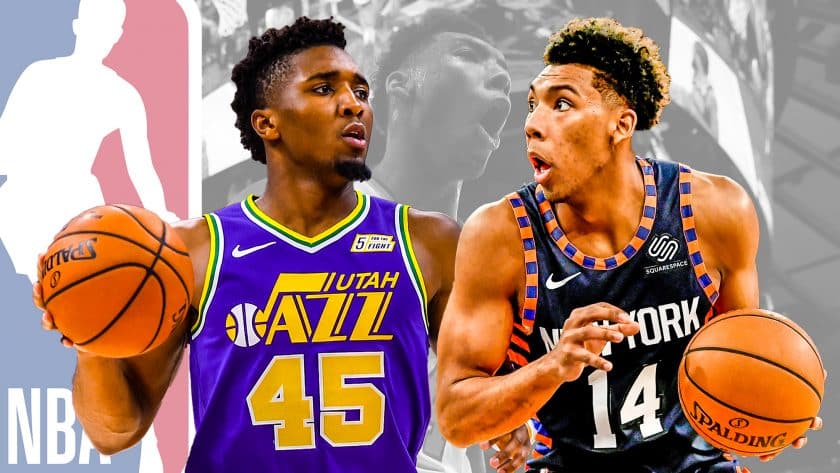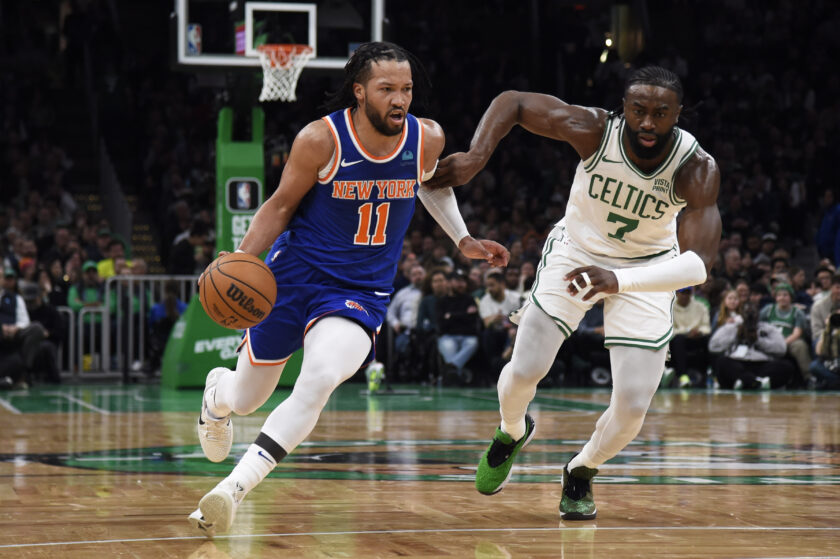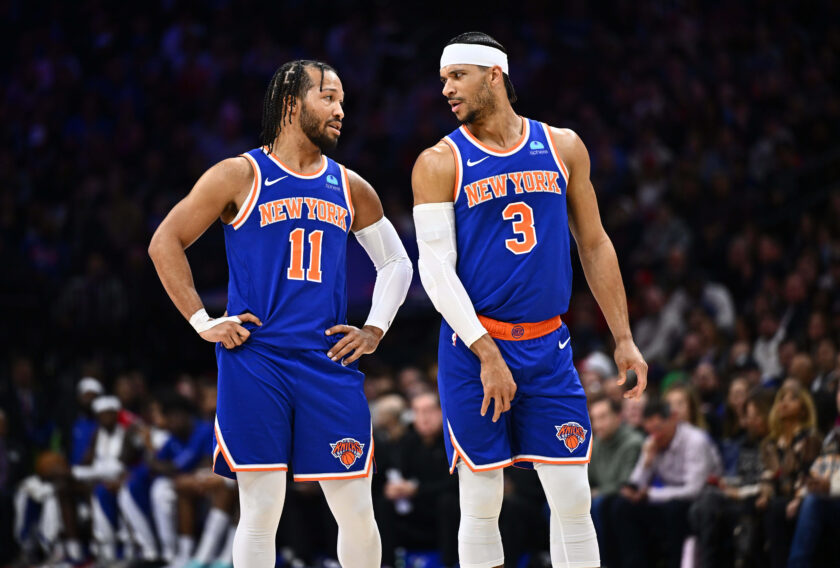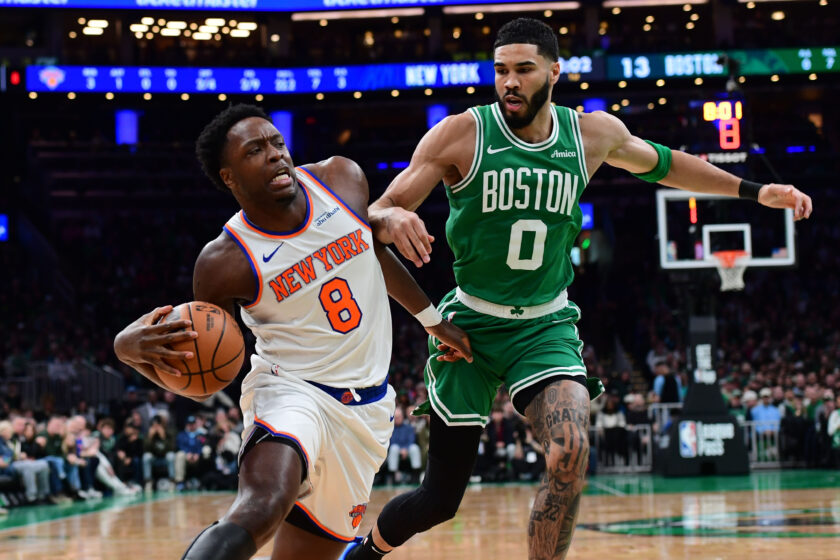New York Knicks G Allonzo Trier has Donovan Mitchell DNA

Allonzo Trier is a pleasant surprise for the New York Knicks. Given more time to develop, Trier may walk a path similar to Donovan Mitchell.
[sc name=”Geoffrey Campbell Banner”]The words potential, opportunity and development might as well be books in the bible for New York Knicks fans over the next several seasons. Perhaps no one more than Allonzo Trier symbolizes the dawn of a new beginning with his impressive play over the first 14 games.
Trier’s supreme confidence and natural scoring ability drew my eye to compare the undrafted talent to new-born star Donovan Mitchell.
Mitchell and Trier are different players with different sets of skills. Yet, both seem to have that prime-time quality and have exceeded expectations relative to draft position. Mitchell was drafted with the 13th pick in 2017 and traded to the Utah Jazz. The Louisville product did not have the cache like some of his peers, but Mitchell quickly separated himself in summer league.
Combining the 2017 summer league numbers from both Salt Lake City and Las Vegas, Mitchell averaged 20.4 points per game on 39 percent shooting over five games.
Trier for his efforts was no slouch as well. Over four summer league games in 2018, the undrafted Arizona product averaged 17 points per game on 45 percent shooting.
But despite his draft position, Trier’s success was no overnight delivery. Roman Stubbs of the Washington Post writes about Trier’s journey across the United States, playing for multiple preps schools since the age of 14.
Stubbs writes:
“Trier may be the purest high school basketball scorer in the country and the most devoted to his craft. He has never attended a homecoming or prom, and he has missed many other traditional high school experiences because his mother, Marcie, taught him early on that if he wanted to live out his ‘American dream,’ he would have to be willing to go anywhere to do it.”
Trier was groomed for the spotlight. As a sixth grader, he shot a commercial with Carmelo Anthony and he’s been building a professional basketball resume since he was a child. That same maniacal work ethic is shared by Mitchell.
Tim Cato of SB Nation chronicles and credits Mitchell’s film work for his rise to stardom. Cato references a previous story written by Seerat Sohi, also of SB Nation, where Mitchell took his athleticism to the next level with some attention to detail with his footwork. Cato explains:
“Mitchell was primarily a two-footed finisher coming out of college, and the Jazz coaching staff gave him a video showing 12 different moves — using one foot, then the other, and so on — around the basket that he should learn. They thought he would work on it all season. Instead, Mitchell showed up to training camp with several of them already in his bag. He shocked trainers at how quickly he would add one, then another, then another.”
Besides the work ethic, both players’ athletic abilities are a major feature of their games. Coming into the league, Mitchell and Trier had similar numbers in the combine. Trier managed to edge Mitchell out in the lane agility drill posting a time of 11.02 seconds, while Mitchell posted a time of 11.53 seconds.
Mitchell’s standing vertical leap (36.5 inches) was better than Trier’s 32 inches. However, Trier just edged Mitchell out in max vertical leap with a jump of 40.5 inches while Mitchell was just short with a leap of 40 inches flat.
[sc name=”Knicks Center”]You can see Trier’s athleticism on display in the following video. Basketball Biomechanics does a great job of breaking down Trier’s ability to change speeds, find space between players, and his ability to control his body in the air. Trier doesn’t have the prototypical body type of an NBA player, but his agility and instincts in traffic are almost elite.
Trier Decel BTB Gallop Hop & Finish
📍Begins buffering momentum w/R limb
📍Immediately gallops w/high dribble=time 2take in visual info while being able 2deceive
📍Foot plants from above=Optimize GRF
*Ball dip helps energy return in2 double pump @bballbreakdown @ISO_ZO pic.twitter.com/tzi3uN3QFR— BBiomechanics (@BBiomechanics) November 5, 2018
Trier and Mitchell also bare similarities in production during the early parts of their career. In October of the 2017-2018 season, Mitchell averaged 9.3 points per game, on 32.9 percent shooting and 28.6 percent shooting from the three-point line. He also averaged 1.4 rebounds per game and 2.8 assists per game.
In October of this season, Trier averaged 9.3 points per game, on 48.1 percent field goal percentage and 45.5 percent from the three-point line. He also averaged 2.8 rebounds per game and 1.3 assists per game.
However, once Mitchell received starter’s minutes in Utah, there was no turning back. During the month of November during the 2017-2018 season, Mitchell helped his team by averaging 18.7 points per game while shooting 41.2 percent from the floor and 37.5 percent from three-point range.
Trier’s per 36 minutes forecast averages of 17.2 points per game, 4.2 rebounds per game and 2.2 assists per game. With the Knicks using this season to develop players, Trier in the starting lineup should absolutely be an option — and it already has once before.
As we move through the next several months of the NBA season, one thing is clear, Trier needs to see as much time as possible in the rotation. And with recent reports surfacing that head coach David Fizdale may be looking to shake things up in the starting lineup, Trier, just as much as anyone else should get a looking at the point guard spot. Frank Ntilikina and Trey Burke have received their shot, and Trier should be next up.
Trier’s numbers in the pick and roll aren’t that impressive yet. Thus far during the 2018-2019 season, Trier produces .75 points per possession which places him in the 33.3 percentile, and while that won’t excite anyone too much, if we’ve learned anything about Trier so far, it’s that he will impress given the opportunity.
If nothing else, this season is about finding the players that may be playing with Kristaps Porzingis for the next five years. I don’t know if Trier is one of them, but we won’t know unless he’s given the chance.
[sc name=”Twitter Follow Link” username=”geoff_boy_ardee” ] [sc name=”Knicks Link Next” link=”https://elitesportsny.com/2018/11/10/new-york-knicks-getting-real-about-kristaps-porzingis-acl/” text=”It’s Time To Get Real About Kristaps Porzingis’ ACL” ] [sc name=”Knicks Footer”]




